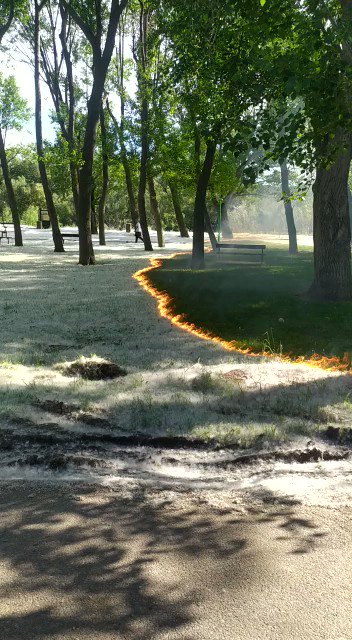Spectators watched in disbelief and awe as a near-uniform line of fire crawled toward them, burning away a mantle of white -- and leaving behind unsinged, green grass.
In early May, as strict lockdown measures were slowly lifting across areas of Spain, a mantle of white fuzz carpeted the ground of Parque del Cidacos de Calahorra in the province of La Rioja, about an hour's drive south of Pamplona, the site of the famed running of the bulls.
Spring had arrived, and white fluff from the poplar trees settled over the grass to create what could be mistaken for a wintry scene.
Eduardo López, a firefighter of the Parque del Cidacos de Calahorra, told the Spanish news organization El País, that the white stuff is poplar seeds which form as fluff. The wind then carried it off the trees and created a layer above the grass that looked like snow. This "
A video posted to social media by the Club de Montaña de Calahorra on May 6 shows a line of fire, barely ankle-high, eating away at the fluff, steadily advancing as the person filming watches in awe. "Mind the lint," is how part of the caption translates.
It was not confirmed whether this instance was a controlled burn or not, but López told El País that controlled burns are performed in the parks to clean the brush, and the flames typically pass quickly enough not to ignite anything apart from the fluff. However, if the flames stay in place and there are dry leaves around, then there is the risk that the fire could take off.
López also ruled out the possibility that heat from the sun had started the fire, as was suggested by some responses to tweets about the blaze. He said that it was very difficult, if not practically impossible, for an instance like that to occur. For the scenario to happen, something like a magnifying glass effect would be required. The most common causes are usually intentional, with someone using a lighter, or accidental, like with a discarded cigarette butt.
CLICK HERE FOR THE FREE ACCUWEATHER APP
In 2019, poplar fluff in Manitoba, Canada, was believed to have worsened the Assiniboine Forest fire.
"The heavy seed load within Assiniboine Forest may have had an influence on the ease of ignition and speed which the fire was able to move," the city of Winnipeg said in a statement to CTV News. Firefighting efforts lasted for at least two days to protect homes from the flames.
Infernos tindered by the fluff raised alarm in parts of Spain toward the end of May last year, some of them caused by people who had seen social media videos of the poplar seeds burning and wanted to try it themselves.
Videos on social networks, instead of acting as a deterrent, are instead stirring up interest and leading to people setting more intense blazes every day, an unidentified firefighter told the Spanish news channel La 8 de Palencia last May. He added that "the blazes have been close to reaching houses, so we are trying to create social awareness and discouraging people from playing with the fluff."
RELATED:




No comments:
Post a Comment